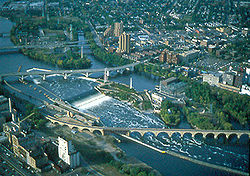
Saint Anthony Falls Laboratory
Encyclopedia

Mississippi River
The Mississippi River is the largest river system in North America. Flowing entirely in the United States, this river rises in western Minnesota and meanders slowly southwards for to the Mississippi River Delta at the Gulf of Mexico. With its many tributaries, the Mississippi's watershed drains...
in Minneapolis, Minnesota
Minnesota
Minnesota is a U.S. state located in the Midwestern United States. The twelfth largest state of the U.S., it is the twenty-first most populous, with 5.3 million residents. Minnesota was carved out of the eastern half of the Minnesota Territory and admitted to the Union as the thirty-second state...
, USA. Its primary research is in "Engineering, Environmental, Biological, and Geophysical Fluid Mechanics". It is affiliated with the University of Minnesota
University of Minnesota
The University of Minnesota, Twin Cities is a public research university located in Minneapolis and St. Paul, Minnesota, United States. It is the oldest and largest part of the University of Minnesota system and has the fourth-largest main campus student body in the United States, with 52,557...
.
The laboratory is unique in that its location next to Saint Anthony Falls allows it to use the hydraulic head
Hydraulic head
Hydraulic head or piezometric head is a specific measurement of water pressure above a geodetic datum. It is usually measured as a water surface elevation, expressed in units of length, at the entrance of a piezometer...
from the waterfall to provide water for many of the experiments.
The experiments performed at the laboratory are varied, and include:
- Contract civil and environmental engineering work, such as dam construction and removal
- Understanding river system dynamics
- Work with oil explorationOil explorationHydrocarbon exploration is the search by petroleum geologists and geophysicists for hydrocarbon deposits beneath the Earth's surface, such as oil and natural gas...
to characterize deposits in deltaic systems - Work to understand the interactions between fluid flow and the ecology of rivers
- Work to understand cavitation in fluids in order to build better propellers
The Saint Anthony Falls Laboratory is also the headquarters of the National Center for Earth-surface Dynamics
National Center for Earth-surface Dynamics
The National Center for Earth-surface Dynamics, or NCED, is an NSF Science and Technology Center- a collaborativepartnership among educational, research, and public/private entities that aims to create new knowledge of significant benefit to society....
, a National Science Foundation
National Science Foundation
The National Science Foundation is a United States government agency that supports fundamental research and education in all the non-medical fields of science and engineering. Its medical counterpart is the National Institutes of Health...
Science and Technology Center.
Research programs
Research at SAFL includes the work of many fields, including civil engineering, hydraulic engineering, hydrology, ecology, and geology. Research at SAFL has been spurred on in the first decade of the 21st century by its status as the headquarters of the National Center for Earth-surface Dynamics (NCED). Facilities at SAFL include the main channel, through which Mississippi River water can be sent for large-scale sediment transport experiments; the delta basins, designed to quickly build experimental stratigraphy; the eXperimental EarthScape facility (XES, nicknamed "Jurassic Tank"), a subsiding basin for large-scale depositional modeling; the Outdoor Stream Lab, which is used to understand fluvial processes and riparian ecology at closer to a field scale; and many other pieces of equipment. The lab is known for rapidly constructing and destructing experimental apparatuses, including full scale models of rivers to understand the effects of dam removalDam removal
Dam removal is the process of removing out-dated, dangerous, or ecologically damaging dams from river systems. There are thousands of out-dated dams in the United States that were built in the 18th and 19th centuries, as well as many more recent ones that have caused such great ecological damage,...
.
Analog material models of fluvial
Fluvial
Fluvial is used in geography and Earth science to refer to the processes associated with rivers and streams and the deposits and landforms created by them...
and depositional
Deposition (geology)
Deposition is the geological process by which material is added to a landform or land mass. Fluids such as wind and water, as well as sediment flowing via gravity, transport previously eroded sediment, which, at the loss of enough kinetic energy in the fluid, is deposited, building up layers of...
systems are employed by geologists at SAFL to understand the causes of river channel morphologies and dynamics, as well as to reconstruct the history of events that produces particular stratigraphic packages
Stratigraphy
Stratigraphy, a branch of geology, studies rock layers and layering . It is primarily used in the study of sedimentary and layered volcanic rocks....
. Researchers working on channel morphology have shown the importance of vegetation in restricting braided channels to a single thread (and often sinuous) system. Research done on experimental alluvial fan deltas has highlighted the statistics of flow occupation and their potential hazard to life and property, shown autogenic cyclicity in patterns of sediment storage and release that determine short-term shoreline positions, and has been connected to sequence stratigraphy
Sequence stratigraphy
Sequence stratigraphy is a branch of geology that attempts to subdivide and link sedimentary deposits into unconformity bound units on a variety of scales and explain these stratigraphic units in terms of variations in sediment supply and variations in the rate of change in accommodation space...
and the processes that form the stratigraphic record.

